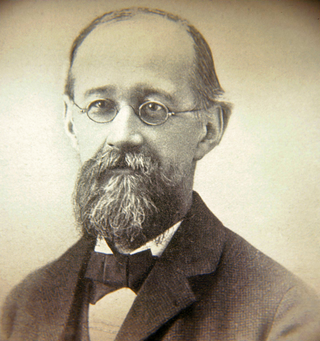Related Research Articles
The Cutter Expansive Classification system is a library classification system devised by Charles Ammi Cutter. The system was the basis for the top categories of the Library of Congress Classification.
The Library of Congress Classification (LCC) is a system of library classification developed by the Library of Congress in the United States, which can be used for shelving books in a library. LCC is mainly used by large research and academic libraries, while most public libraries and small academic libraries use the Dewey Decimal Classification system. The classification was developed by James Hanson, with assistance from Charles Martel, in 1897, while they were working at the Library of Congress. It was designed specifically for the purposes and collection of the Library of Congress to replace the fixed location system developed by Thomas Jefferson.

A library classification is a system used within a library to organize materials, including books, sound and video recordings, electronic materials, etc., both on shelves and in catalogs and indexes. Each item is typically assigned a call number, which identifies the location of the item within the system. Materials can be arrange by many different factors, typically in either a hierarchical tree structure based on the subject or using a faceted classification system, which allows the assignment of multiple classifications to an object, enabling the classifications to be ordered in many ways.

A library catalog is a register of all bibliographic items found in a library or group of libraries, such as a network of libraries at several locations. A catalog for a group of libraries is also called a union catalog. A bibliographic item can be any information entity that is considered library material, or a group of library materials, or linked from the catalog as far as it is relevant to the catalog and to the users (patrons) of the library.

This page is a glossary of library and information science.

A research library is a library that contains an in-depth collection of material on one or several subjects. A research library will generally include an in-depth selection of materials on a particular topic or set of topics and contain primary sources as well as secondary sources. Research libraries are established to meet research needs and, as such, are stocked with authentic materials with quality content. Research libraries are typically attached to academic or research institutions that specialize in that topic and serve members of that institution. Large university libraries are considered research libraries, and often contain many specialized branch research libraries. The libraries provide research materials for students and staff of these organizations to use and can also publish and carry literature produced by these institutions and make them available to others. Research libraries could also be accessible to members of the public who wish to gain in-depth knowledge on that particular topic.

Charles Ammi Cutter was an American librarian. In the 1850s and 1860s he assisted with the re-cataloging of the Harvard College library, producing America's first public card catalog. The card system proved more flexible for librarians and far more useful to patrons than the old method of entering titles in chronological order in large books. In 1868 he joined the Boston Athenaeum, making its card catalog an international model. Cutter promoted centralized cataloging of books, which became the standard practice at the Library of Congress. He was elected to leadership positions in numerous library organizations at the local and national level. Cutter is remembered for the Cutter Expansive Classification, his system of giving standardized classification numbers to each book, and arranging them on shelves by that number so that books on similar topics would be shelved together.
Sanford Berman is a librarian. He is known for radicalism, promoting alternative viewpoints in librarianship, and acting as a proactive information conduit to other librarians around the world. His vehicles of influence include public speaking, voluminous correspondence, and unsolicited "care packages" delivered via the U.S. Postal Service. Will Manley, columnist for the American Library Association (ALA) publication, American Libraries, has praised Berman: "He makes you proud to be a librarian."
A faceted classification is a classification scheme used in organizing knowledge into a systematic order. A faceted classification uses semantic categories, either general or subject-specific, that are combined to create the full classification entry. Many library classification systems use a combination of a fixed, enumerative taxonomy of concepts with subordinate facets that further refine the topic.

Medical Subject Headings (MeSH) is a comprehensive controlled vocabulary for the purpose of indexing journal articles and books in the life sciences. It serves as a thesaurus that facilitates searching. Created and updated by the United States National Library of Medicine (NLM), it is used by the MEDLINE/PubMed article database and by NLM's catalog of book holdings. MeSH is also used by ClinicalTrials.gov registry to classify which diseases are studied by trials registered in ClinicalTrials.
The Library of Congress Subject Headings (LCSH) comprise a thesaurus of subject headings, maintained by the United States Library of Congress, for use in bibliographic records. LC Subject Headings are an integral part of bibliographic control, which is the function by which libraries collect, organize, and disseminate documents. It was first published in 1898, a year after the publication of Library of Congress Classification (1897). The last print edition was published in 2016. Access to the continuously revised vocabulary is now available via subscription and free services.

Minnie Earl Sears formulated the Sears List of Subject Headings, a simplification of the Library of Congress Subject Headings. In 1999, American Libraries named her one of the "100 Most Important Leaders We Had in the 20th Century."

In library and information science, cataloging (US) or cataloguing (UK) is the process of creating metadata representing information resources, such as books, sound recordings, moving images, etc. Cataloging provides information such as author's names, titles, and subject terms that describe resources, typically through the creation of bibliographic records. The records serve as surrogates for the stored information resources. Since the 1970s these metadata are in machine-readable form and are indexed by information retrieval tools, such as bibliographic databases or search engines. While typically the cataloging process results in the production of library catalogs, it also produces other types of discovery tools for documents and collections.

The following outline is provided as an overview of and topical guide to library and information science:
Knowledge organization (KO), organization of knowledge, organization of information, or information organization is an intellectual discipline concerned with activities such as document description, indexing, and classification that serve to provide systems of representation and order for knowledge and information objects. According to The Organization of Information by Joudrey and Taylor, information organization:
examines the activities carried out and tools used by people who work in places that accumulate information resources for the use of humankind, both immediately and for posterity. It discusses the processes that are in place to make resources findable, whether someone is searching for a single known item or is browsing through hundreds of resources just hoping to discover something useful. Information organization supports a myriad of information-seeking scenarios.

The following outline is provided as an overview of and topical guide to books.
Faceted Application of Subject Terminology (FAST) is a general use controlled vocabulary based on the Library of Congress Subject Headings (LCSH). FAST is developed as a part of WorldCat by OCLC, Inc., with the goal of making subject cataloging less costly and easier to implement in online contexts. FAST headings separate topical data from non-topical data, such as information about a document's form, chronological coverage, or geographical coverage.
Dewey-free refers to library classification schemes developed as alternatives to Dewey Decimal Classification (DDC). Dewey-free systems are often based on the BISAC subject headings developed by the Book Industry Study Group, and are typically implemented in libraries with smaller collections. Instead of using numerical notation to indicate a document's shelving location, Dewey-free systems organize documents alphabetically by natural language words. Dewey-free systems have been implemented in both public and school libraries.
The Brian Deer Classification System (BDC) is a library classification system used to organize materials in libraries with specialized Indigenous collections. The system was created in the mid-1970s by Canadian librarian A. Brian Deer, a Kahnawake Mohawk. It has been adapted for use in a British Columbia version, and also by a small number of First Nations libraries in Canada.

The Répertoire de vedettes-matière de l'Université Laval (RVM) is a controlled vocabulary made up of four mostly bilingual thesauruses. It is designed for document indexers, organizations that want to describe the content of their documents or of their products and services, as well as anyone who wants to clarify vocabulary in English and French as part of their work or research.
References
- Brinkler, Bartol. The geographical approach to materials in the Library of Congress subject headings. Library Resources & Technical Services 6, no. 1 (Winter 1962): 49-64.